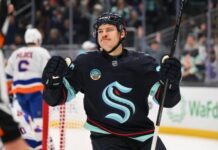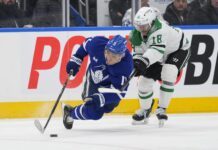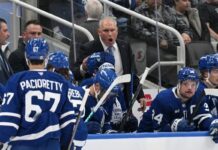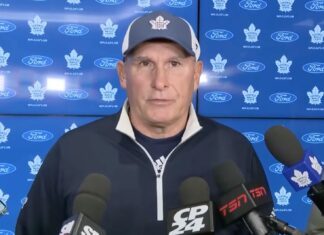The final installment of Anthony Petrielli’s interview with Toronto Maple Leafs Director of Amateur Scouting Dave Morrison touches a little more on the ins and outs of the scouting process, catches up on the progress of a few members of the 2013 draft class (including Frederik Gauthier), and looks ahead to the 2015 Draft. Here’s Part One and here’s Part Two.
Anthony Petrielli: I’ve noticed a theme in your draft history where you give a late pick or two to Thommie Bergman to use. Has there been any thought in bringing him overseas to pick apart the OHL or the USHL, or something along those lines?
Dave Morrison: He comes over every year. On that note, and I’ve had to explain it a few times, some of these Swedish players we’ve drafted some of our North American guys have liked better than Thommie has. I don’t want to take anything away from Thommie, but it’s not just Thommie drafting these players. I really want to make a note that Peter Ihnacak, our number two guy in Europe, is really involved as well and does a lot of scouting in Scandinavia. I think to say it’s Thommie Bergman alone would be a little bit misleading. The picks Thommie has made, outside of maybe one in the last 9 or 10 years, have been seen by a lot of our scouts. Also, to say that we don’t lean on Thommie would be untrue because we do lean on him for some of the players in the area, like we would lean on any other scout when we draft a player from their area. When we drafted Morgan Rielly, I leaned a lot on Garth Malarchuk and Roy Stasiuk from the West. Those guys knew this player, they had a longer background. I just wanted to make sure that what I thought was right they believed also. When we draft a guy from Sweden, even though we like him as a staff and Thommie likes him, I am going to go to Thommie and say, “is this right? what we’re seeing, is that correct?” That’s where Thommie has done a fantastic job. He’s done a really good job. He has also identified them initially. That’s all a part of the process and that’s where Thommie has done a really good job, but it’s not just Thommie and nobody else sees them. That’s not correct. When we draft a player we draft them as a team, and everybody else is involved as well.
AP: With video in play, does that cut down on travel time?
DM: No, not really. We still see as many games as we always see, there’s just more now on video. We have a guy in our office now who breaks down video for us. We have a website we use and we basically post video to this website of the potential draft picks we are watching. Certain games, we’ll ask for the shifts to be broken down so we can check to see if what we saw was right.
AP: They’ll cut every shift that a player has played and you can watch it quickly?
DM: Yes, exactly. There’s only so many hours in a day, and sometimes it’s perfect if you’re sitting in an airport or whatever, you can just flip on the internet and boom there it is. You can watch 10 or 15 minutes and kind of confirm or maybe not confirm what you think.
AP: Looking at the last draft, you guys went three USHL picks in a row. Do you think maybe that league is underscouted or underrated? They all sound like players with a good shot.
DM: Vesey came out of New England junior, which is not really USHL. I think it’s a real good league, it’s very fast and very competitive. It’s become a lot more offensive the last few years and I think the quality of the play continues to get better every year. I think there’s a lot of good things coming out of that league. I don’t know why, but I think we’ve had guys from there ranked pretty high and it just hasn’t hit us in the right spots. I think this year it was a funny draft in a way and it just happened those kids were in those spots. We had no hesitation about taking them out of this League, we’re confident in taking those players out of the USHL. I think there’s enough good players that come out of there that we can say it’s a quality league.
AP: Would that have played a part in not trading up into the second round?
DM: I think ideally we would’ve liked to get into the second round. It has to make sense and the cost has to be right. We would’ve liked to have had a second round pick, I think there was a lot of quality there still, but it just didn’t happen.
AP: That’s a tough thing on you as a staff, not having those picks (no second round pick this year, or last).
DM: Honestly, the more picks you have, the greater chance you have of producing players and ultimately that’s how you’re measured, right? But we’re all team guys, and whatever is best in terms of trying to make the big team better, that’s got to be the bottom line.
AP: Let’s take a look at a few of the guys who you previously drafted — Frederik Gauthier, his numbers weren’t worse than last year, but he hasn’t necessarily progressed as hoped. I thought he might take a step offensively and not have around the same numbers. What happened with him, do you think?
DM: One of the things I think happens following your draft year — I just don’t think he had the proper time to train. I think he went from his season, to the U18s, to the combine, to the draft, to the development camp, to the world junior camp, to his own junior camp, to the regular season, to the world juniors, and I don’t think he had enough time to really train and work on certain aspects of his game. We’re hopeful this year that he is going to push the envelope a little more offensively and hopefully his numbers will reflect that. You just look at the year after a kid gets drafted and quite often it’s not quite what you wanted it to be. Some of them get hurt because they don’t get the proper time to train. In some ways, he’s obviously gotten a little bigger and a little stronger, and you can see his skating has improved — I was really happy with what I saw from him last week. Hopefully he’s going to start really pushing the envelope, and this is the year he starts to make those strides in the offensive direction that we’d like him to make. I know he’s committed, so we’re anxious to see.
AP: Do you think there are any other guys in the junior leagues who are ready to make the Leafs think twice in terms of keeping them with the big club or getting a little stint to start the year?
DM: Obviously, there might be some Marlies kids with that potential, certainly because of the experience and the year they had last year. I think there’s a few kids who might open some eyes. They’re confident, they’re talented, so you just never know. You never know who is going to surprise. Sometimes it’s a lot more seamless with some players than with other players. I can’t pinpoint what it is — maybe it’s hockey sense, sometimes it’s just a certain amount of confidence they have between the years, the ability to make that adjustment. I’m curious to see if a bunch of these kids are going to make those decisions really tough come September.
AP: I’ve coached minor hockey and, after a full summer of working out or whatever, they come back and it’s like night and day. That’s so hard to account for how much they change over the summer.
DM: It really is. I’m not sure what age group you have, but some years those kids change so much and it’s so dramatic. By the time they’re at this age, it can still make a huge difference physically. Some of them just become men from one year to the next. When I was down at the MCC last week, I saw a couple of the Marlies kids and I just couldn’t believe how much they had changed and become men. You could just tell — facially, physically, talking to them, maturity wise — there was a big difference in them. For some of them it happens quickly, for some of them it happens gradually; that’s Mother Nature. Some of them are luckier than others and some of them need to work a little harder, but that’s where the character comes in.
AP: On that note, apparently Carter Verhaeghe is 6’2 now?
DM: He’s another kid who is not small. He’s another guy who has lots and lots of talent. Just physically, how long until he’s strong enough to play at the pro level for 82 games? The mind, the hands, the talent is there.
AP: He’s already grown quite a bit… he wasn’t that big when you drafted him, right?
DM: No, he definitely has grown. Connor Brown is another kid who, while still not a huge kid, he’s not small anymore. He’s grown a couple of inches since we drafted him and he’s probably 20 pounds heavier. That’s another thing — you look back historically at drafts and some of these players now in the NHL, when they were drafted, were really quite small. They put on 20 or 30 pounds and next thing you know — as small skilled players they learned to survive — and now, no longer small, it’s like, “look out.”
AP: Do you like Connor’s odds of making it?
DM: There’s no question in my mind that he’s going to knock on the door. This kid is a determined kid with so much talent that he’s going to will himself into a position to give himself that chance. I would never say a kid will get there for sure and play 10-15 years — I’d never make those type of predictions — but I would predict this kid is going to give himself a chance. He just seems to be one of those guys who bucks the odds, you know?
AP: He’s one of those guys who sleeps and breathes it, kind of thing.
DM: Just when you think, “oh this is going to be tough for him,” he turns it around and becomes a difference maker. I would never bet against him, let’s put it that way.
AP: A bunch of people have been comparing the 2015 draft to the 2003 draft, which is something that shouldn’t be taken lightly. The 2003 draft was jaw dropping, how good it was. Do you think the 2015 one has the potential to be that good?
DM: At this point, the indications are that it’s going to be a real good one. Whether it’s going to be that good is a bit premature, but could it come close? Potentially. I would say it’s going to be better than a lot of the drafts in the last number of years. To be as good as that one would be tough, but you never know. It’s a bit premature; if you ask me half way through the year, I’ll have a better idea of what I think. Just right now, it looks like it has the potential to be a real good one.
AP: Teams must be guarding first round picks with their lives.
DM: Yes. Especially at the high end. You’d hate to lose out on one of those top guys if something ever went wrong. There’s just depth to it at the top, too. You’re starting out with two exceptional kids in McDavid and Eichel, and then you’ve got a group of kids that are really, really talented as well in their own right who are probably going to make their mark, too. It’s kind of an exciting year to be looking forward to.
AP: With Shanahan in the fold, do you anticipate any changes with the staff or how you conduct business? Or is it going to be status quo?
DM: I don’t think it’s going to be status quo, but I think anything we do will be done methodically. That was the same with Dave Nonis; Dave is obviously still the GM. I think things are going to be done methodically and there’s going to be a process. In the last couple of years we’ve done that, especially in terms of development with the young players. I think that’s going to continue on. How we do things — there’s going to be a plan to it, a process to it. There’s always been that, and I just think it’s going to be even more the case. There will be accountability as there always has been, from the players to the scouts to everyone in the organization. That has to be part of this process for everybody.
AP: So, maybe more of a focus on the development side versus the drafting, in terms of process?
DM: No, I just mean that in the last few years, there’s been a lot more — if you look at the Marlies with nine playoff series in three years — I think there’s been more [development focus]. We have three development coaches, we’ve got a good size scouting staff — and I know my guys are working really hard — so the integration of the players, the type of players we want, to actually getting them in our system, and getting them from their amateur teams to the Marlies… We’ve just put a lot more effort into that in the last two or three years. I think it’s really going to pay off here, as soon as next year. It’s just been the whole process — from the draft, to the development process from the Marlies to the Leafs — I just think there’s been more emphasis. That’s a good thing; in today’s NHL you have to have that.
AP: Some people take it a little overboard, like I’ll hear people say the Leafs should hire 100 amateur scouts to scout the edges of the Earth.
DM: There’s some people in the scouting business who think smaller staffs are a lot more ideal. There’s less opinions, so if you hire the right people you don’t need that many. I think you can have a larger staff, and have the right people as well, and have a certain level of communication. I’ve tried to make it so that our scouting staff is a team. We work in unison and we have our own little team that has to be on the same page. That’s what I’ve tried to do with our staff. I really like the group that we have.
AP: It’s really subjective; there are so many different angles you can look at.
DM: It is. Not everyone is going to agree with what you want to do. But we all have to stand behind what we want to do, in both our successes and failures. And if it’s a failure — what can we do to correct it the next time? If it’s a success, it’s the same thing — let’s try to do that again when we’re looking at other guys. Your group has to be really communicative. You’ve got to have guys who are always talking to each other; from the part time to the regional guys, there has to be those levels of communication. That’s how you get better and that’s what leads to better decisions.
AP: I was watching the St. Louis Blues behind the draft special, and it was when they drafted David Perron. One scout said, “he handles the puck like he’s Kovalev.” Another scout is saying, “every time I watched him he just floated around the ice doing nothing.” That’s such a hard thing to account for: Who watches what when the player is playing, how do you balance that?
DM: That’s all part of the consistency. That’s part of the development in learning how to be pros. When they have a down game, what are they doing for their team? On those days when it’s not their best day, what are they doing to help the team? That’s kind of what becoming a pro is all about, the consistency of helping your team win, whether you’re having your A game or your B game. That’s a part of development.
AP: Anything you’d like to add, something that hasn’t been mentioned and you’d like to get out there?
DM: I think we touched on a lot of good things. I think it’s important that our kids — because of a lot of this negative stuff — that they believe there is some positive things out there about them. I think it’s a real strong group in my opinion. I’m excited to see where this group of kids can go. There is a lot of potential and there is a lot of potential NHL players. I just hope that they believe in themselves. I think they do. That’s a good thing. Our development coach — Jimmy Hughes — is doing a real good job there. I’m really happy with how things have gone. The way the organization is treating this team right now is really good. The little moves we made are smart, they make sense, they’re the core, kind of character type of kids you need in your lineup. I think the younger kids are going to be a little older. Sometimes they have to be the guys who make the difference. I’m optimistic with how things are going. There’s going to be more tweaking for sure, but I think I like the way they’re really analyzing and making thoughtful moves.
Click here to read Part 1 of this interview with Dave Morrison
Click here to read Part 2 of this interview with Dave Morrison

































